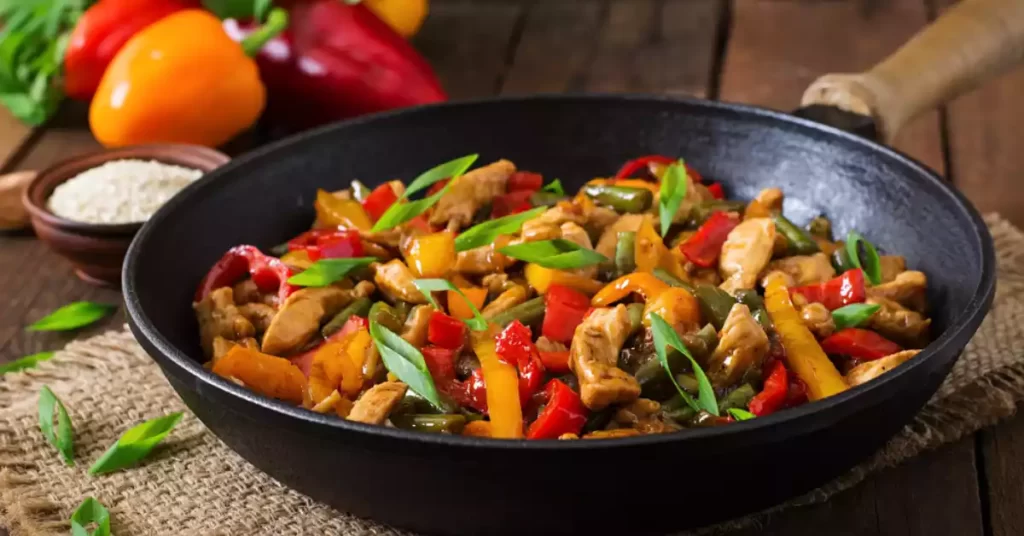The concept of stir fry, a quick sauté of assorted ingredients in a hot pan, is as diverse as the various cultures that have embraced it. Originating from the culinary heartlands of China, the art of stir fry is more than just a cooking method; it is a testament to the evolution of Chinese cuisine and its impact on global food culture.
Stir fry’s popularity can be traced back to its ease, versatility, and the perfect balance of taste it brings to the table. Despite the numerous variations it has undergone, the basic idea remains the same: a quick, high-heat cooking technique that preserves the ingredients’ flavor and nutritional value.
Indeed, this vibrant and exciting cooking technique carries centuries of tradition, adaptation, and cultural exchange. Understanding its history and origin can give us a richer perspective on not just stir fry itself, but also on the cultural narratives it represents.
Historical Roots of Stir Fry
Earliest Evidence of Stir Frying
While the term “stir fry” may seem modern, its roots are steeped in ancient history. The first recorded use of this cooking method dates back to the Zhou dynasty in China, around 1046–256 BC. Though rudimentary, the principles of stir fry were evident in the quick, high-heat cooking technique used then.
Influence of Traditional Chinese Cooking
In traditional Chinese cooking, harmony and balance are key principles. These principles are embodied in the concept of stir fry. The balance between different ingredients, textures, and flavors is what sets stir fry apart. The use of different cooking techniques and ingredients in one dish is a testament to the balance and harmony Chinese cuisine strives for.
Evolution of Stir Fry Technique
Stir Fry during the Han Dynasty
The Han Dynasty marked a significant evolution in the stir fry technique. Improved culinary tools like iron pans enabled cooking at higher temperatures. This development allowed for quicker cooking, enhancing the flavors while preserving the nutrients, a hallmark of stir fry.
Stir Fry during the Ming Dynasty
During the Ming Dynasty, stir fry became even more popular. Innovations in farming and the availability of diverse ingredients allowed cooks to experiment and refine the technique. Recipes from this era provide a glimpse into the evolution of stir fry, highlighting the various combinations of ingredients and sauces used.

Stir Fry Outside of China
Introduction of Stir Fry to Other Cultures
As Chinese traders and immigrants began to travel and settle in various parts of the world, they brought along their culinary traditions, including stir fry. It soon caught on in other cultures, evolving according to local tastes and available ingredients.
Stir Fry in Western Cuisine
Stir fry has also made a significant impact on Western cuisine. Its introduction in the early 20th century brought about a change in the way food was prepared. With its quick and easy technique, it provided a refreshing contrast to the elaborate, time-consuming cooking methods prevalent then. Today, stir fry is a staple in many Western kitchens, with numerous variations.
Key Ingredients in Traditional Stir Fry
Basic Components of Stir Fry
A traditional stir fry comprises a protein, vegetables, a base sauce, and a staple like rice or noodles. The protein can be meat, tofu, or seafood, while the vegetables can range from bell peppers to bok choy. The sauce often combines salty, sweet, and spicy flavors.
Regional Variations in Ingredients
Different regions have added their unique twist to stir fry. For instance, the Szechuan region is known for its bold, spicy stir fry, while Cantonese stir fry is milder and more focused on the fresh flavors of the ingredients.

Influence of Stir Fry on Modern Cooking Techniques
Fusion Cuisine and Stir Fry
Stir fry has played a significant role in the development of fusion cuisine. Chefs around the world have adapted the technique to incorporate flavors from various cultures, creating unique and delicious combinations.
Stir Fry in Today’s Health-Conscious World
Given the growing focus on healthy eating, stir fry fits perfectly with its quick cooking process that retains the nutritional value of the ingredients. Additionally, it allows for a good balance of proteins, vegetables, and carbs, making it a healthy and balanced meal choice.
Frequently Asked Questions
When was stir fry first used?
The first recorded use of the stir fry cooking technique dates back to the Zhou dynasty in China, around 1046–256 BC.
What is the significance of stir fry in Chinese cuisine?
In Chinese cuisine, stir fry represents the principles of balance and harmony, combining different flavors, textures, and ingredients in one dish.
How has stir fry influenced modern cooking techniques?
Stir fry has significantly influenced modern cooking techniques, particularly in the development of fusion cuisine. It has also made a mark in the health food sector due to its ability to retain the nutritional value of the ingredients.
Conclusion
The journey of stir fry from the ancient kitchens of China to global culinary fame is nothing short of remarkable. It speaks to the adaptability and timeless appeal of this cooking technique that it has not only endured but thrived through centuries of culinary evolution.
The story of stir fry is one of cultural exchange and fusion. It reflects how food transcends geographical and cultural boundaries, shaping and being shaped by the diverse cultures it encounters.
Ultimately, the charm of stir fry lies in its simplicity and flexibility. Whether you prefer it spicy, tangy, sweet, or mild, there’s a stir fry out there for everyone. This enduring culinary tradition continues to evolve, taking on new flavors and forms, as it continues to delight our palates. Stir fry truly is a testament to the rich tapestry of culinary history.

